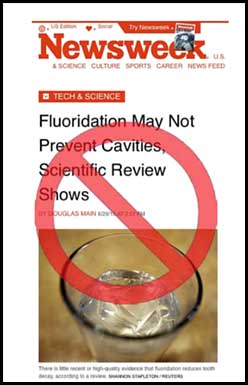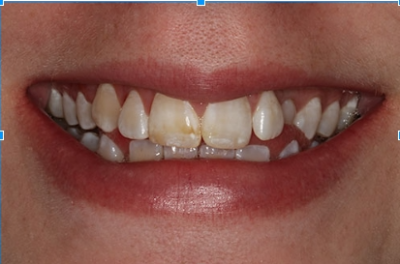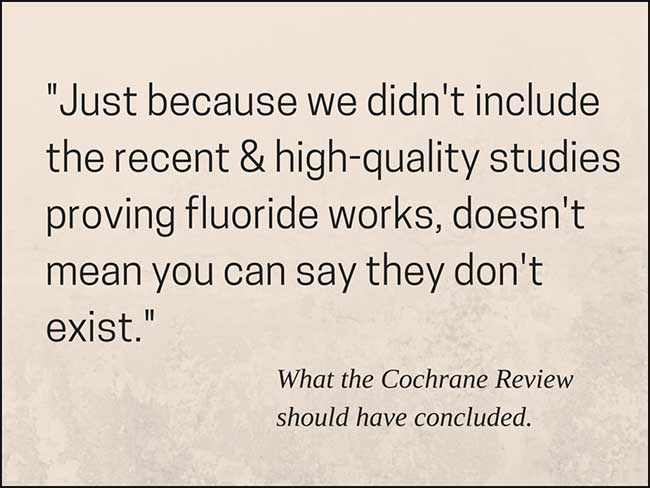
To paraphrase Britney Spears (my apologies to all), “Ooops, [Newsweek] Did It Again.” Oh yes, sadly, they did – their fearless and misinformed journalist Douglas Main has jumped into the proverbial fluoridated waters and misinterpreted yet another study about fluoride effectiveness. He had a bit of help this time, however, in that the article found here is actually based on a Cochrane Review from the Cochrane Collaboration, generally considered to be one of the best sources of systematic reviews of the scientific literature on a particular topic. This time….not so much. That’s not to say that the Review is bad, per say, but there are some significant weaknesses that Main conveniently ignores while overstating the minimal conclusions that can realistically be made.
Starting with Previous Bad and Debunked Claims
Main starts by referencing several of his own previous articles in Newsweek relating to studies that purportedly link Community Water Fluoridation (CWF) to ADHD, underactive thyroid, and endocrine (hormone) disruption. Referencing your own journalism is not considered kosher in the scientific literature and does nothing to support your claims, but when those articles and studies have already been shown to be fundamentally flawed, he’s really starting off poorly. The study and related article about an alleged link between ADHD and CWF has been thoroughly debunked here, here, and in my own rebuttal here. The claims of an alleged link between CWF and underactive thyroid have been discussed here and here.
Strike 1 for Main
As is typical, anti-fluoridationists do a good job of misstating and misrepresenting science that doesn’t necessarily agree with them in order either (1) make the science itself look bad, or (2) make it look as if the science supports them when it actually doesn’t. So let’s go through the specific claims made by Douglas Main and look at what the Review says or doesn’t say.
Yes, Water Fluoridation Has Been Proven Effective
Main starts off with an awful mischaracterization of the Review by stating that “…while using fluoridated toothpaste has been proven to be good for oral health, consuming fluoridated water may have no positive impact.” Let’s take that apart quickly.
First of all, there’s no disagreement that fluoridated toothpaste has been good for oral health. However, to state that consuming fluoridated water may have no impact is to completely ignore all historical evidence as to the dramatic decrease in dental decay once standardized CWF was implemented for the first time in Grand Rapids, Michigan 80 years ago. Not only that, the Cochrane Review directly contradicts Main’s assertion:
“Data suggest that the introduction of water fluoridation resulted in a 35% reduction in [DMF] baby teeth and a 26% reduction in [DMF] permanent teeth. It also increased the percentage of children with no decay by 15%.”
Strike 2 for Main
How About the Quality of the Papers Included?
Next up, Main claims that the Review “…winnowed down the collection to only the most comprehensive, well-designed, and reliable papers.” Is that accurate? Sigh……no. No it’s not. Let’s turn back to the Review to see what it says [emphasis mine]:
“For caries data, we included only prospective studies with a concurrent control, comparing at least two populations, one receiving fluoridated water and the other non-fluoridated water, with at least two points in time evaluated. Groups had to be comparable in terms of fluoridated water at baseline. For studies assessing the initiation of water fluoridation the groups had to be from nonfluoridated areas at baseline, with one group subsequently having fluoride added to the water. For studies assessing the cessation of water fluoridation, groups had to be from fluoridated areas at baseline, with one group subsequently having fluoride removed from the water.”
In other words, the Review only selected what are called “prospective” studies. While these are generally considered to be of higher quality better than cross-sectional studies, (performed at one point in time) for identifying causes, they are also much more difficult, and sometimes impossible, to do. They are especially difficult today for one important reason when it comes to fluoride: because so many communities have already been fluoridated for a long time, it is very difficult to find one or more in which to set up a prospective study today, and the regulatory hurdles in doing so are enormous.
Therefore, it is false to claim that the Review only included the “most comprehensive, well-designed, and reliable papers.” In fact, the Review included one type of study regardless of their quality. Beyond that the Review’s discussion actually noted that more recent cross-sectional studies were often of better quality because computer use enabled better statistical analysis and consideration of confounding factors.
Strike 3 for Main
The U.S. Dept. of Health & Human Services responded to this particular weakness of the Review in their Press Release of July 2, 2015 PDF available here, stating (with citations) that more recent cross-sectional studies are of excellent quality and address the other concerns cited by the Review in not including more studies, even of RCTs:
“These studies opted to collect data at one point in time among adults with or without lifetime exposure to fluoridation and then look back to the time when their permanent teeth would have erupted free of tooth decay. In these studies, the researchers used statistical methods to control other factors, such as age, education, and other fluoride exposures, that could affect the relationship between fluoridation and tooth decay. Findings show that water fluoridation resulted in lower caries levels in adults who were exposed to fluoridation even after other sources of fluoride, such as fluoride toothpaste, became widely available.”
Not only that, there is the question of general study quality. The Review judged quality using blinded randomised controlled studies (RCTs) commonly recommended for clinical drug trials as their baseline. However, they acknowledged this criteria is usually impossible to achieve in fluoridation studies because the assignment of subjects into a treated group versus a control group is outside the control of the investigator. Instead, researchers must use observational studies. Dr John Beal noted in his response to the Cochrane Health Group’s blog The value of cross-sectional studies on the dental benefits of water fluoridation – a response from Dr John Beal to the Cochrane Oral Health Group blog, the claim that cross-sectional, observational, studies, which were all excluded, are somehow of lower quality than RCTs, is false because a previous Cochrane Review said they’re similar!
“It is interesting to observe the conclusions of a different Cochrane review published last year (Anglemyer at al) which compared a range of study designs applied in various fields and concluded that, on average, “there is little evidence for significant effect estimate differences between observational studies and RCTs, regardless of specific observational study design”.
Well now, isn’t that interesting? The previous Cochrane Review specifically found that the 2 study types yield comparable results in terms of quality, but now this one says the cross-sectional ones aren’t good enough. Admittedly, it would be nice if the Cochrane Review would apply more consistent standards in the selection and exclusion criteria to avoid confusion.
Strike 4 for Main
At this point, we can safely ignore almost every quote from Kathleen Thiessen, Dr. Philippe Grandjean, Christine Till and Ashley Malin, and even Trevor Sheldon, because they are clearly and explicitly referring only to the prospective studies included and ignoring all the other recent cross-sectional studies. Disingenuous at best, outright misleading at worst. The quote by Kathleen Thiessen is particularly egregious – the Review never suggests that stopping fluoridation would be unlikely to increase the risk of tooth decay. Not once. And again, Main writes “When it comes to fluoridation research, even the best studies are not high quality.” FALSE! The correct statement would be, “The studies in the Cochrane Review are not necessarily of the highest quality by today’s standards, but there are other much more recent and high quality studies that the Review didn’t include.”
Now let’s look at the Review’s Conclusions, and bear in mind that this is taken directly from the Review. The only editing is my adding of emphasis in bold text:
“The available data come predominantly from studies conducted prior to 1975, and indicate that water fluoridation is effective at reducing caries levels in both deciduous and permanent dentition in children. Our confidence in the size of the effect estimates is limited by the observational nature of the study designs, the high risk of bias within the studies and, importantly, the applicability of the evidence to current lifestyles. … There is insufficient evidence to determine whether water fluoridation results in a change in disparities in caries levels across SES. We did not identify any evidence, meeting the review’s inclusion criteria, to determine the effectiveness of water fluoridation for preventing caries in adults.
There is insufficient information to determine the effect on caries levels of stopping water fluoridation programmes.
Did you notice a certain pattern there? “Our confidence…is limited…” “We did not identify any evidence…” “There is insufficient information…” “The evidence is limited…” How in the world does Douglas Main turn that into “fluoridation doesn’t work!” As the saying goes, “The absence of evidence for something is not the same evidence for the absence of that something.”
On the Cochrane Oral Health Group blog response to the criticism, the authors stated that their conclusions were not as clearly defined as could have been due to word and space limitations. However, Dr. Ken Perrott suggested a far more concise and accurate conclusion could be made thus:
“The majority of the selected studies (71%) were conducted prior to 1975. Most recent studies were cross-sectional and therefore not considered. Consequently no conclusion could be drawn about the widespread use of fluoridated toothpaste on the effects of water fluoridation. Selection limitations also prevented any conclusions about the effects of socio-economic differences, stopping water fluoridation or preventing caries in adult. “ Dr. Ken Perrott
So What About Fluorosis?
Pardon my bluntness, this section of the article made my head hurt because it’s just plain dumb. I’m only going to address it because otherwise someone will think I’m glossing over it and trying to pretend it’s not there, as if Main actually has a valid point. But the sheer exaggeration and hyperbole of the statements by Main and Sheldon must be shown as such, because I’m a full-time, “in-the-trenches” dentist looking at teeth 4-5 days a week, 48 weeks per year, for over 17 years in the city of Charlotte, NC that has had CWF since 1949. Nearly 11,000 patients seen, and you know how many of them have had fluorosis so bad that they actually bothered them enough to do something? Less than 20. You know what fluorosis usually looks like? It typically looks like this:

So when Main writes, “On average, about 12 percent of people in fluoridated areas have fluorosis bad enough that it qualifies as an ‘aesthetic concern’…” and he quotes Sheldon as saying, “that’s a ‘huge number,” I’m left shaking my head in disgust at the hyperbole. 12% is a “huge number” in what universe?
Anyway, the 12% figure is not even correct if we are talking about the effect of fluoridation because the prevalence was 10% in non-fluoridated areas. That’s right – even in non-fluoridated areas the prevalence of dental fluorosis of cosmetic concern due to natural fluoridation is estimated as 1o%. That leaves just two percent of fluorosis from CWF. Statistically and practically meaningless.
At least Main concedes, “A total of 40% of people in fluoridated areas have some level of fluorosis, though the majority of these cases are likely unnoticeable to the average person.” [emphasis mine] Exactly! But even that’s overstated, because as I just said, the prevalence of all forms of dental fluorosis in non-fluoridated areas was calculated to be 33% – so that the prevalence of all forms due to fluoridation is only 7%! But then Sheldon is once again cited as thinking of the “obvious downside of fluorosis.” Huh? Didn’t Main just write that it’s “likely unnoticeable?” So Sheldon thinks that fluorosis is a big enough downside to not approve fluoride today despite the fact that most fluorosis is “likely unnoticeable?” Where’s that Star Trek Triple Facepalm meme when you need it?
Strike 5 for Main
Douglas Main is OUT!
So what’s the real take-home message of this particular Cochrane Review? Here’s all they really said: “Our exclusion criteria meant that only 9 studies were reviewed. Regardless of the quality of other studies done, we ignored them. Based on the extremely small study size and the strict criteria applied, all we can say is that more contemporary RCTs prospective studies are called for, because the ones available are old and might be biased.” That’s it! Main and his interviewees, however, go straight to, “OMG IT DOESN’T WORK WE SHOULD STOP IT NOW!” Perhaps this will make the point more clearly:

ADDITIONAL NOTES:
* This article is specifically intended as a rebuttal of Douglas Main’s article in Newsweek. It is not intended as a thorough analysis of the Cochrane Review itself, although I have included in it links to a number of the public critiques and comments.
** This article was written in collaboration with Making Sense of Fluoride, an international group of students, academics, and medical professionals dedicated to ensuring the public is accurately informed about the safety and efficacy of fluoride in the prevention of tooth decay, as well as countering the misinformation in the public domain.
** It should be noted that Royal Society of New Zealand recently released a far more comprehensive look at the subject of Community Water Fluoridation, and Dr. Ken Perrott just published an excellent point-by-point comparison of what the NZ Fluoridation Review (Eason et al, 2014) and the Cochrane Review say.






